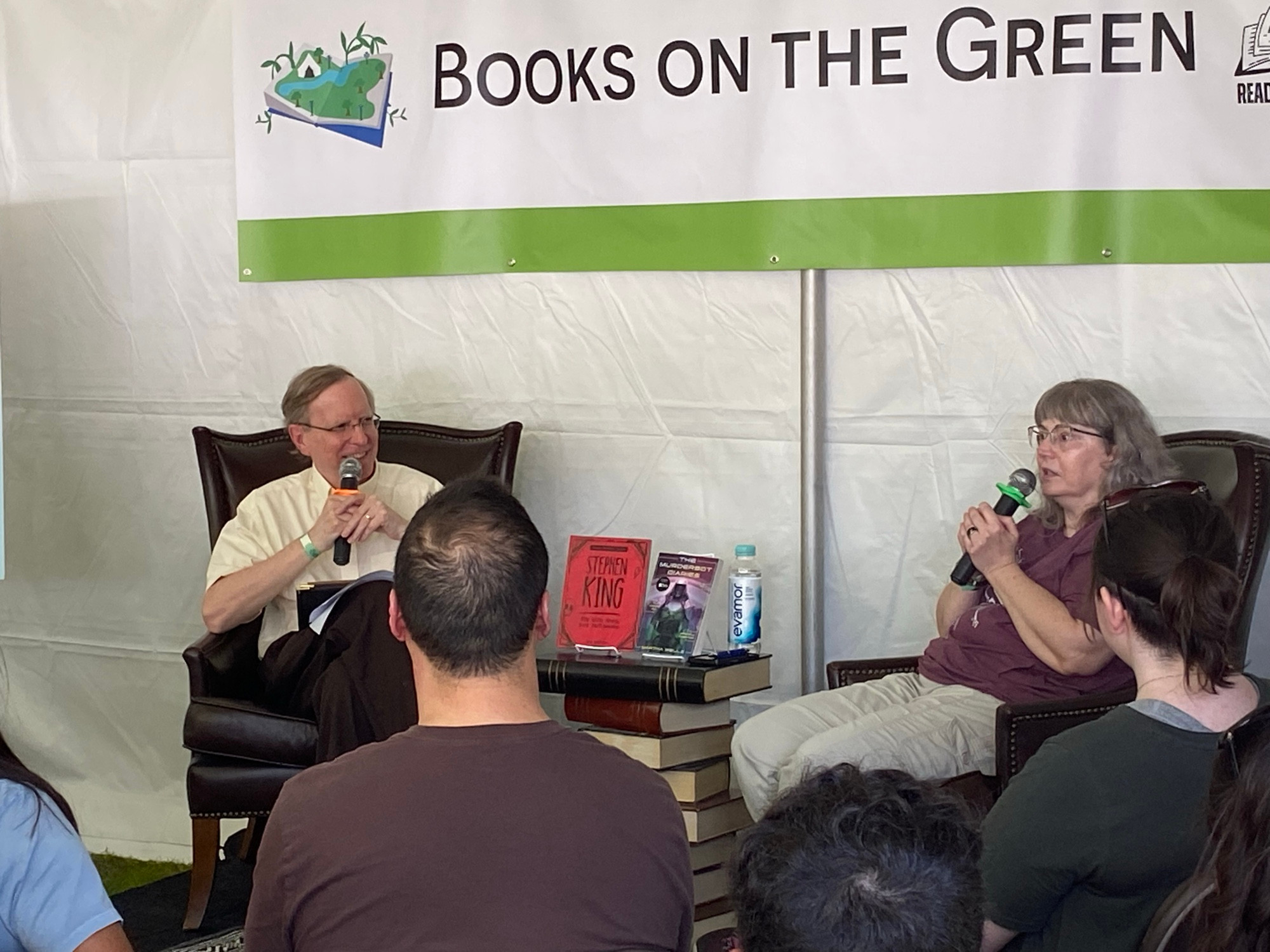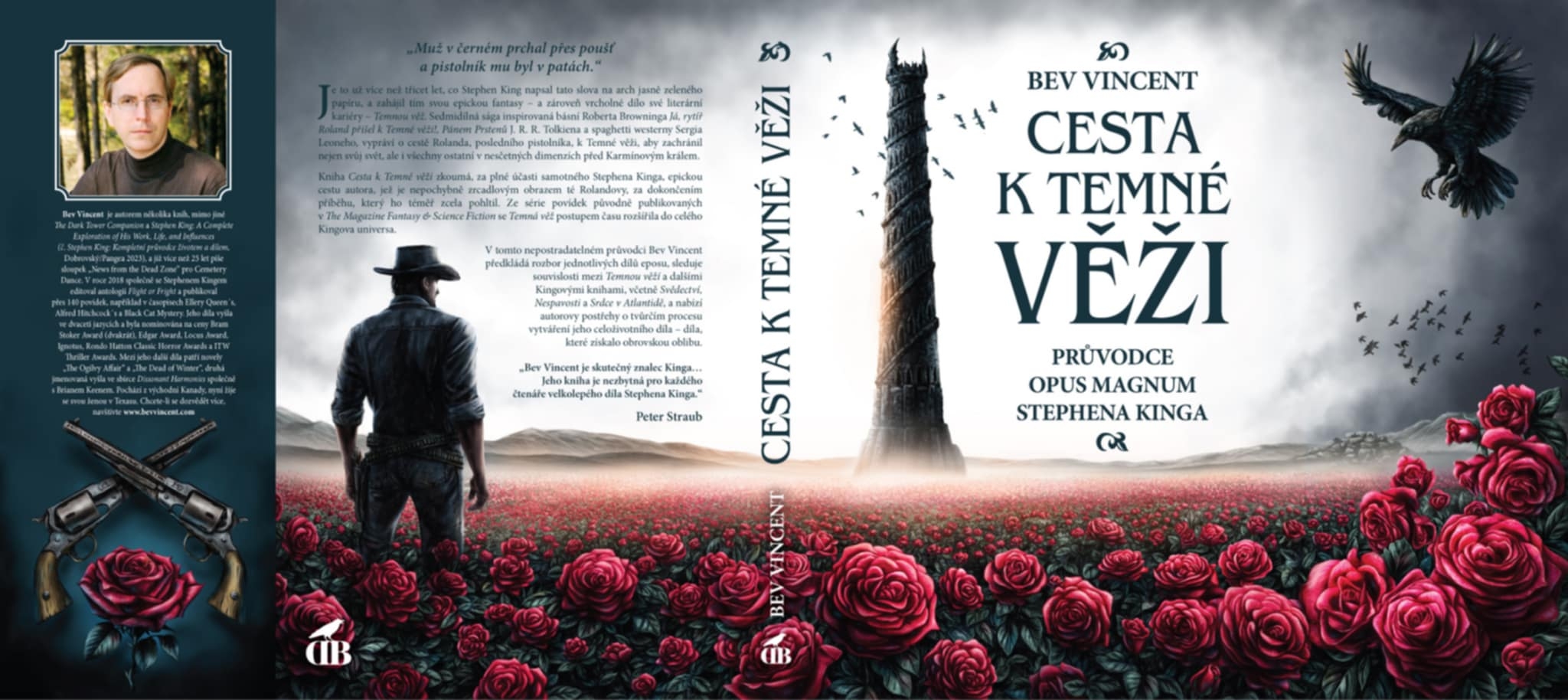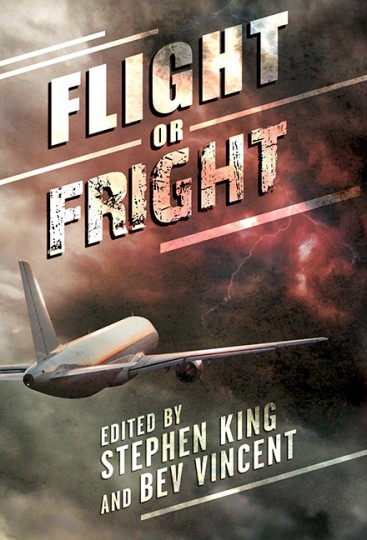I have been interviewed quite a few times over the years. I’ve also had the good fortune to be able to interview a wide range of people as well including authors, movie directors, producers, film and TV actors, artists, publishers and musicians. Often, these interviews have been for print or online publication. On occasion, though, I’ve been invited to ask people questions in front of a live audience. Those situations are a little different because I’m not looking to get information for myself. I’m facilitating a discussion on behalf of the audience.
Yesterday, I interviewed author Martha Wells at the Books on the Green portion of the Woodlands Arts Festival. It was a beautiful afternoon, warm but not oppressively so, with a bit of a breeze, in a cozy venue in the heart of a vibrant arts event with booths by local artists. Quite well attended. The organizer of Books on the Green runs an independent bookstore in our community and she invited Martha Wells, author of numerous fantasy and science fiction novels and novella, to attend. Wells lives in College Station, which is about 80 miles away from here. The organizer was hopeful but not optimistic that her invitation would be accepted, but it was.
Then, Wells said she preferred to be interviewed rather than giving a talk, so the shop owner asked me if I’d conduct the interview, to which I agreed. Many of the people I’ve interviewed in a live setting in the past have been people about whom I know a fair amount already: Mick Garris and Joe Hill, to name a couple. Last fall I interviewed Daniel Kraus at the River Oaks Theater—I didn’t know much about him or his work previously, so I had to do a lot of prep. Similarly, I wasn’t all that familiar with overall Wells’ career, so I read a lot of her available interviews and articles about her career to put together enough questions to fill a 45-minute slot.

It helped greatly that the Apple TV+ adaptation of Wells’ first Murderbot novella launches next month. That was something people in the audience were very interested in hearing about. But we had a good talk, I think, about the ups and downs of her career and some of the other interesting things she’s done, like writing background stories for a Magic: The Gathering extension pack.
So, what else has been going on lately? We’re still four months out from the release of The End of the World As We Know It: New Tales of Stephen King’s The Stand, but the publicity engine should be gearing up for that soon. I’m doing one interview related to the project this month, and Joe Lansdale and I will be appearing together at Murder by the Book on release day. I still haven’t had the opportunity to read many of the other stories in the anthology, but I plan to rectify that very soon.
I have some other short stories in the pipeline, but don’t have the final details about them yet. Stay tuned!
The Czech limited edition of The Road to the Dark Tower was announced in March. It is lavishly illustrated by Jiří Dvorský, and I can’t wait to see the final product as I think it’s going to be a beauty. This edition features a new introduction by me and an afterword by Kealan Patrick Burke. I mean, look at that:

I was very pleased to learn that Stephen King: His Life, Work, and Influences (Young Readers’ Edition) made the following lists from the Children’s Book Council:
- Teacher Favorites 9th to 12th grade
- Librarian Favorites 9th to 12th grade
- Young Adult Favorites 9th to 12th grade
Each year, children, teens, teachers, and librarians across 50 states read newly published K-12 grade books and vote for the ones they like best. Over 70 coordinators nationwide display hundreds of publisher-submitted titles in their schools and libraries so that every book can be read and voted on. The books with the most votes become the annual CBC Favorites Awards Lists, a group of 12 lists showcasing new books that young readers, teachers, and librarians loved reading. The CBC then promotes these lists nationally as resources for all educators and children’s book lovers. So that’s an honor.
I’m also awaiting the official announcement for another project about which I am beyond excited, but it’s just one of those things where I’m sworn to secrecy. A couple of things, actually, now that I think about it.
I have written a few book reviews lately. You can find them at Onyx Reviews, my long-running review site.
I’m currently rewatching The West Wing and wishing that reality wasn’t stranger than fiction. Oh, how we could do with a Bartlett in the White House instead of a “fill in the blank.” I also made it through to the end of my rewatch of Homicide: Life on the Street, including the two-hour movie following season 7.
I recently wrapped some excellent, truly excellent series, including season 2 of Severance, The Residence—which is a semi-jocular whodunit with a terrific cast—and The Pitt, which is the most gripping and accurate medical drama I’ve ever seen, bar none.
Paradise was quite good, too, as were Zero Day and Landman. I ran hot and cold on the current season of Yellowjackets, which just wrapped up its third season. Although they have a five-season plan, I think that’s stretching it and I wouldn’t mind at all if they found a way to bring it all home next season. The Rig is entertaining enough, although never of quite the same caliber as other series. I really disliked the main character in Prime Target, but it was a fun romp through the world of mathematics—although as someone with a minor in math I was never convinced that any of the equations we saw scribbled in notebooks or on whiteboards could do anything approaching what they’d have us believe.
Douglas is Cancelled was an unexpected, brief punch to the gut. I wasn’t quite as fond of Adolescence as others seemed to be. I thought the single-take trope was unnecessary, creating some very awkward staging, except in episode 3, where all the action takes place in one room.
Currently watching: Bosch Legacy, which is nearing its conclusion, and the quirky series Ludwig, wherein a man who is really good at puzzles pretends to be his missing brother, a homicide detective.
Recent reads include Wreckage, the unfinished novel by Peter Straub, and a companion book What Happens in Hello, Jack, which will be published by Subterranean Press this year. That led me back to a reread of his previous novel, A Dark Matter, and some of the associated novellas and stories. I enjoyed Scott Carson’s Departure 37 so much I read it twice, once for myself and once to my wife. The City and Its Uncertain Walls by Haruki Murakami was pretty strange, and I have no idea what he had in mind when he wrote it. I’m currently reading Frankie by Graham Norton to my wife and am about to tackle Nightshade, the forthcoming Michael Connelly. I’ll reread Never Flinch by King soon, in preparation for writing my review.
Last night we saw A Complete Unknown, the Dylan biopic. Timothée Chalamet does an excellent job of channeling Dylan, who’s never been one of my favorite singers. My real introduction to him was when he released Slow Train Coming during my first year at university and I don’t need to hear “Gotta Serve Somebody” ever again. Watching this movie, I realized I’m not familiar with any song Joan Baez wrote, only the songs she covered. There’s one historical figure from that era who I’ve met in person, albeit briefly: I once kicked Peter Yarrow from Peter, Paul, and Mary out of a seat at the folk festival he runs in Kerrville, a story I’ve no doubt told before.
We also watched the documentary Merchant Ivory and were surprised to learn how many of their most famous films were done on shoestring budgets, a wish and prayers. It was a fascinating look at their creative process and lives.
We were disappointed with Section 31, which was a disaster in just about every way imaginable. However, I had a great time watching The Monkey with my friend Danel Olson and a bunch of students from his class. It’s the only film I’ve seen in a theater this year and it is totally bonkers. Over the top zany, but funny and fun. Of course, I think I’m in a minority in that I also enjoyed Longlegs.
There are some really promising King adaptations coming up this year, so I think I’ll be headed back to the cinema a few times before the year is over.

